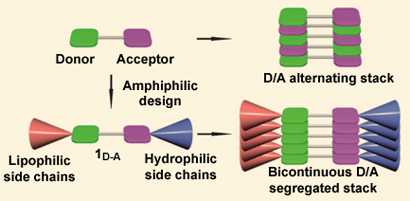Organic molecules combining aromatic, lipophilic and hydrophilic segments can organise themselves into structures with five times the photoconductivity of structures like those typically adopted by aromatic groups alone. These higher performance nanofibre electronic films will enable improved organic solar cells, the Japanese and Chinese researchers who developed them hope.
Producing organic photoconductive and photovoltaic devices relies on combining electron donating and accepting aromatic molecules, says Takanori Fukushima of the Japanese national laboratory Riken. 'When an organised structure with segregated donor and acceptor arrays is exposed to light, electron transfer takes place to generate a hole in the donor array and an electron in the acceptor array,' Fukushima explains.
However, devices exploiting this approach rarely live up to performance expectations, because such molecules assemble with donor and acceptor groups sandwiched between each other. 'Alternating stacks of donor and acceptor units may trap generated charge carriers and are therefore unfavourable for photoconduction,' Fukushima told Chemistry World.
To tackle the problem Fukushima, along with Takuzo Aida of the University of Tokyo and Wei-Shi Li of Shanghai Institute of Organic Chemistry conceived a different assembly approach. They started by synthesising straight-chain molecules containing conventional oligothiophene donor and perylenediimide acceptor groups. In one case they attached a lipophilic group to each end, and in another they attached lipophilic and hydrophilic groups on opposite ends, making amphiphilic molecules.

Using incompatible side-chains overcomes the tendency of organic donor-acceptor molecules to self-assemble into alternating stacks, providing an electronically preferable segregation
© Chem. Asian J.
|
A nanofibre film made with the amphiphilic molecules achieved maximum photoconductivity five times that of a film made with only the lipophilic side chain molecules. The researchers determined that the difference arose because the molecules with only lipophilic side chains assembled in an alternating stack structure, while in the amphiphilic molecules the donors and acceptors were well separated. 'We were excited about the difference in photoconductivity, since this indicated that our side-chain incompatibility strategy works for 1D objects,' Aida says. '1D assembly is one of the desired configurations for photovoltaics.'
Dmitrii Perepichka, who works on organic electronic films at McGill University, Canada, notes that while electronic properties can today be rationally designed into organic molecules, controlling how they assemble is less precise. 'Side-chain incompatibility is a very interesting and, apparently, fruitful approach to solve this problem in a rational way,' he says. 'It might take a while before the suggested amphiphilic assembly will lead to a better performing solar cell on the market, but this certainly is the way to go.'
Andy Extance
Interesting? Spread the word using the 'tools' menu on the left.




